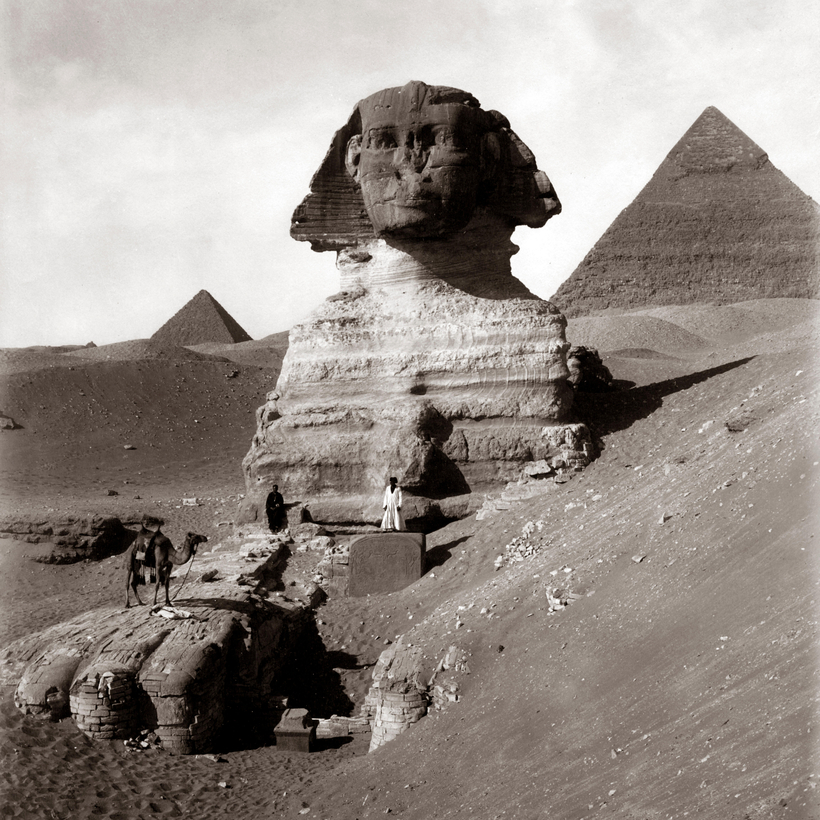For all its posterior romance, 18th- and 19th-century Egypt was something of an acquired taste for the Westerner. Eliza Fay, an intrepid and self-possessed traveler, stopped over in Alexandria in 1779. Observing Mount Horeb on her passage down the Red Sea, she was reminded of the “flight of the children of Israel”: “And you may be sure, I did not wonder that they sought to quit the land of Egypt, after the various specimens of its advantages that I have experienced.” One man’s (or, for once, woman’s) trash, another’s treasure. Toby Wilkinson’s cracking A World Beneath the Sands: The Golden Age of Egyptology abounds with alternative, more appealing “specimens.”
Before Napoleon descended on North Africa, ancient Egypt was shrouded in centuries of mystery and—Wilkinson’s title is no exaggeration—sand. The Roman emperors Julius Caesar and Hadrian made celebrated tours. Records of subsequent foreign visits are spottier. Arabic scholars turned up in the 12th and 13th centuries, including Jamal al-Din al-Idrisi, who wrote the earliest known text on the pyramids. With the Turkish conquest of the Nile Valley in 1517, European interest—animated by the “first stirrings of Renaissance thought”—and access resumed. Firsthand accounts veered between an idle mysticism and impressive guesswork. The 17th-century grand tourist George Sandys surmised that the pyramids were royal tombs. In 1726, the versatile Jesuit missionary Claude Sicard identified the ruins at Luxor as the “hundred-gated Thebes” of legend. Yet these were solitary amateurs. It would take the convergence of the French Revolution’s imperial pretensions and Enlightenment ideals to set the foundations for Egyptology.
Napoleon in Egypt
In February 1798, Talleyrand proclaimed that “Egypt was a province of the Roman Republic; she must become a province of the French Republic.… The Romans wrested Egypt from kings distinguished in arts and science; the French will lift it from the hands of the most appalling tyrants who have ever existed.” A hybrid military-scientific outfit was duly authorized, with Napoleon at its head. The degree of intellectual intent was reflected in the composition of the 151 “experts” enlisted, nearly half of whom were printers, surveyors, architects, mathematicians, naturalists, astronomers, artists, or archaeologists. Napoleon seized Alexandria on the morning of his landing and within the month had entered Cairo. British intervention under Nelson at Abukir Bay that August stranded Napoleon, carrying his mission’s scholarly purposes to the fore.
Confronted with the splendors of Thebes, “the army came to a stop by itself and spontaneously burst into applause.” The French measured the Great Pyramid at Giza—“calculat[ing] that there was enough stone in the three main pyramids to build a wall half a metre thick and three metres high all the way around France”—cleared sand from the Sphinx, and, while strengthening fortifications in anticipation of the second Battle of Abukir Bay, which Napoleon would win, discovered “an irregularly shaped slab of granite … covered with a lengthy inscription.” The upper part was in hieroglyphics, the lower part in Greek, and the middle in an unknown cursive script. Napoleon’s experts immediately grasped the importance of the multi-lingual stone, dubbed “Rosetta” for the garrisoned port town where it was found: “Perhaps it will give us the key [to the study of hieroglyphic characters] at last.”
Teasing out its secrets was, however, decades away. The expedition’s interim returns were dire. Napoleon abruptly left the field to Mehmet (re-styled Muhammad) Ali, an Albanian-Ottoman officer who became pasha of Egypt in 1806. A quarter of France’s experts were dead—from battle, assassination, plague, dysentery, drowning, and sundry ill effects of their adventure—within eight years. And, as in 18th-century India and America, their British rivals claimed the prize. When the French Army surrendered in August 1801, its antiquities, notably the Rosetta stone, were declared spoils of war and sent to London.
The longer-term ramifications of Napoleon’s folly on the Nile were profound. The autocratic, modernizing dynasty that would rule Egypt throughout Wilkinson’s titular “golden age” was established and the Anglo-French competition firing Egyptology’s definitive set pieces had been kindled. Mark one for France for Jean-François Champollion’s decipherment of the Rosetta stone in 1822, and one for England, exactly 100 years later, for Howard Carter’s (alas, no relation) discovery of Tutankhamen’s tomb.
Napoleon’s experts grasped the importance of the multi-lingual stone, dubbed “Rosetta.” Teasing out its secrets was, however, decades away.
Wilkinson’s bookending narratives of Champollion and Thomas Young, the self-effacing British polymath to Champollion’s self-promoting French swotter, and Carter and his patron, Lord Carnarvon, whose death by mosquito bite inspired the legend of Tut’s curse, cannot but charm even the most jaded and familiar. But it is with the less heralded, often peculiar figures, episodes, and advances of Egypt’s long 19th century that The World Beneath the Sands distinguishes itself.
For every John Gardner Wilkinson, the gentleman scholar and antiquarian who initiated readers into The Manners and Customs of the Ancient Egyptians (1837), there is an odious Howard Vyse, an army man seemingly lifted from the pages of Tom Sharpe, whose favored method of archaeological inquiry was “blasting.” (Wilkinson regretted the “Rhine tourists” and Cheapside “legions” his works invited.) Germans, Americans, and women would enter the desert fray. Lucie Duff Gordon, who found bats and swallows “quite sociable,” and Amelia Edwards, who took refuge in Egypt “as one might turn aside into Burlington Arcade … to get out of the rain,” were models of cool in conditions little improved by the era’s gradual professionalization of Egyptology.
Gaston Maspero, the foremost French Egyptologist of the 1880s, wished to see those who “imagine[d] that archaeology is an armchair science … dangling from a rope, with a 30-metre shaft beneath their feet and an inscription to copy at the bottom of the shaft.” Carnarvon judged it “an occupation for the damned.” Flinders Petrie’s game-for-anything wife, Hilda, recalled of her sleeping quarters: “At the head of my bed are 4 great cartonnage heads of mummy cases with staring faces, at the side are collections of alabasters and many bones hard by; at the foot of the bed are 80 skulls.” Still, the allure of Egypt persisted—and persists. On their “day of days,” Carnarvon peered at the tomb’s dimly lit second doorway in suspense: “Can you see anything?” “Yes,” Carter marveled, “it is wonderful.”
Max Carter is the head of the Impressionist and Modern Art department at Christie’s in New York


